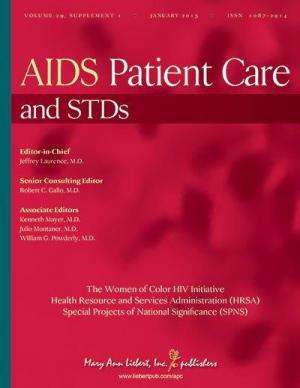Findings from the Women of Color HIV Initiative published

African Americans currently account for nearly half of all new HIV diagnoses, and among females, 64% of new HIV diagnoses affect Black/African American women. A series of articles reporting results from the Women of Color HIV Initiative, including topics such as linkage and barriers to care, treatment adherence, viral suppression, substance abuse, and violence, are published in a special issue of AIDS Patient Care and STDs.
The Women of Color HIV Initiative is a prospective study of more than 920 women who were enrolled in HIV care at one of nine sites (six urban and three rural) across the United States between 2010 and 2013. The Initiative was a Special Projects of National Significance funded by the U.S. Department of Health and Human Services Health Resources and Services Administration.
Arthur E. Blank, PhD, Albert Einstein College of Medicine, Bronx, NY, served as a Guest Editor of this special issue and as a contributing author. In the article "Health Status of HIV-Infected Women Entering Care: Baseline Medical Findings from the Women of Color Initiative," E. Byrd Quinlivan, MD and coauthors, University of North Carolina at Chapel Hill, New York University, City University of New York, and Albert Einstein College of Medicine, report the activity limitations and health conditions affecting the study participants on entering HIV care. The women had more physical and mental health concerns than the general female population in the U.S. and, in particular, cardiovascular disease and diabetes were associated with activity limitation.
Elizabeth A. Eastwood, MD and colleagues, City University of New York, New York University College of Nursing, University of North Carolina at Chapel Hill, Albert Einstein College of Medicine, SUNY Downstate Medical Center, and SUNY School of Public Health, Brooklyn, NY, compare the sociodemographic features of the women who enrolled in HIV medical care. Urban women tended to report more barriers to care, substance abuse, and sexual risk behaviors. Women treated at urban sites were also, for example, more likely to be Hispanic, unemployed, and less educated, as described in the article "Baseline Social Characteristics and Barriers to Care from a Special Project of National Significance Women of Color with HIV Study: A Comparison of Urban and Rural Women and Barriers to HIV Care."
"Across the United States, Black/African American and Latina women are disproportionately affected by HIV, and many face daily struggles to engage in and remain in HIV primary care," says special issue Guest Editor Arthur E. Blank, PhD. "The articles in this issue use a variety of traditional and novel research approaches to document the barriers women of color face, and the factors that contribute to engaging and retaining them in care."
More information: The issue is available free on the AIDS Patient Care and STDs website.





















